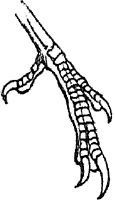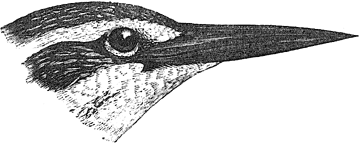|
Page 38 | prev page next page | ||||
|
Suborder HALCYONES No caeca. Oil-gland tufted. 15 cervical vertebrae. Sternum with four notches on the posterior margin; manubrium simple, composed of the spina externa only. Both carotids are present. Spinal feather-tract well defined on the neck and not forked on the back, so there is no dorsal apterium. Down present in adults on the tracts not covered by feathers, a character absent in other suborders of Anisodactyli. No accessory semitendinosus muscle. The two plantar tendons are generally united, but the slip leading to the hallux branches off from the flexor perforans digitorum above the junction as in Meropes. In some cases however, as in Dacelo, this slip unites with the flexor longus hallucis, and the latter runs to the fourth digit only and has no other connexion with the f. perforans digitorum (Gadow in Newton’s Dictionary of Birds, p. 617).
Family ALCEDINIDAE Bill long, stout, pointed, with a rounded or slightly flattened culmen; tarsus and toes feeble; the fourth or outer toe united to the third for more than half its length, third and second united for basal third. Primaries 11, the first minute. Tail-feathers 12 (except in Tanysiptera, which has 10). All Kingfishers lay white, glossy, rather round eggs, very like those of Bee-eaters, almost always in a chamber without lining, dug by the birds in the earth at the end of a burrow from 6 inches to several feet in length. There is sometimes, but rarely, a layer of fish-bones on which the eggs are deposited. This family is generally divided into two sub-families, but as Dr. Bowdler Sharpe, to whom we are indebted for an excellent monograph of the Kingfishers, has shown, the distinction between the two is not well marked.
Key to the Genera
Bill long, compressed; culmen slightly curved, flattened or rounded above, with a groove on each side. Wings rather pointed, 2nd or 3rd quill longest, 1st but little shorter. Tail longer than culmen. This genus inhabits the Ethiopian and Oriental regions with the southern portion of the Palaearctic and the whole of America, There are two Indian species, distinguished by their black and white plumage.
Key to the Species
Fig. 34 - head of C. varia Coloration: Male. Crown, nape, and small nuchal crest black, sparingly streaked with white; lores and a long supercilium white, a black eye-streak from the base of the bill to the ear-coverts, connected by a narrow black line with the black gorget; an imperfect white collar; back, scapulars, and wing-coverts black edged with white. Rump-feathers white, with large black spots. Primaries with outer web and terminal portion of inner black, the rest white. Secondaries white, with irregular black markings forming imperfect bars. Tail-feathers white on the basal half and on the tip, a broad black band occupying the greater part of the distal half; lower parts, with cheeks and wing-lining, white; some small elongate spots forming a malar patch; two gorgets, the upper the broader, on the breast, and spots on the flanks forming an imperfect belt, black. There are often black spots on the throat. Females want the posterior black gorget and the anterior is interrupted in the middle, Bill black; iris brown; legs and feet blackish; soles pale (Legge). Size: Length about 11.7; tail 3; wing 5.5; tarsus 0.4; bill from gape 3. The Indian bird has usually been referred to the African and Western Asiatic C. rudis; but the latter differs in having the basal half of the tail-feathers more or less spotted with black, the black subterminal bands marked with large white spots, and the black marks on the throat and flanks less developed. The two are, however, only just separable. Distribution: Common throughout India, Ceylon, and Burma in the plains, wherever there are rivers or large pieces of water, except in Tenasserim south of Amherst. This Kingfisher ranges east to China, but not west of Baluchistan, and does not inhabit the Himalayas, even to the westward, above a very moderate elevation. Habits: The Pied Kingfisher avoids forest, but is found haunting all waters in open country. It may be seen on tidal streams and creeks, on backwaters and even on the sea-shore, though it is more common inland on rivers, marshes, ditches, and tanks. It lives entirely on fish, for which it never plunges from a fixed perch, but it flies over the water, and hovers with its beak pointed downwards, at a height of frequently 15 or 20 feet above the surface, when it suspects the presence of a fish. It dives for its prey after hovering, but not unfrequently checks itself in its plunge and flies on, uttering from time to time a sharp twittering cry. It breeds from the end of January till April, and lays 4 to 6 white, glossy, broadly oval eggs at the end of a hole usually made in the perpendicular bank of a river. The eggs measure about 1.18 by 0.94.
Coloration: Male. Crown and long nuchal crest, with the sides of the head to some distance below the eyes, black, with white oval spots, that become streaks at the side. A broad white collar; remainder of upper parts greyish black or dark grey, with white bars. Quills and tail black, with transversely elongate white spots. Lower parts including cheeks white, a stripe of black spots from the point of the chin down each side of the throat, widening behind and joining a broad gorget of black spots, the wider part and the gorget tinged to a varying extent with brownish rufous that is rarely entirely wanting. Flanks, wing-lining, and under tail-feathers barred or spotted with grey or black. Female. No rufous on throat or gorget; under wing-coverts pale rufous brown. Bill black, greenish at the base; iris dark brown; legs and feet olive-green. Size: Length about 16; tail 4.3; wing 7.4; tarsus 0.5; bill from gape 3.3 Distribution: Throughout the Himalayas as far west as Kashmir, and up to an elevation of 7000 feet to the westward, less to the eastward; also in the hills south of Assam, and in the Tenasserim hills, but not, so far as is known, in the intervening country. This species is also found in parts of China and in Japan.
Habits: This Kingfisher is only found on wooded hill-streams, though it follows them in places for some
distance into the plains. It generally occurs in pairs. It lives on fish entirely, and usually sits in a bush
near the water, keeping in the shade; it swoops upon fish generally from its perch, but according to Mr. Baker,
who has given an excellent account of its habits, it sometimes hovers like C. varia. The same observer
says this bird has two notes, one like that of other Kingfishers, but less quickly repeated, the other a
guttural croak which serves as a call. It breeds from April to Tune, arid lays 3 or 4 large white, rounded eggs
in a chamber at the end of a hole about 2 feet long. |
| ||||
| prev page :: next page | |||||
 birding.in
birding.in
| Birds | Bird Diagram | Ornithology | Indian Sites | Bird Watching | Migration | North India | Birds of India | Haryana |
All rights reserved. Copyright © 2005-2013 Birds and birding in India. Disclaimer
website: Free Java Guide & Tutorials

